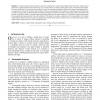Free Online Productivity Tools
i2Speak
i2Symbol
i2OCR
iTex2Img
iWeb2Print
iWeb2Shot
i2Type
iPdf2Split
iPdf2Merge
i2Bopomofo
i2Arabic
i2Style
i2Image
i2PDF
iLatex2Rtf
Sci2ools
TVCG
2010
2010
Origamizing Polyhedral Surfaces
—This paper presents the first practical method for “origamizing” or obtaining the folding pattern that folds a single sheet of material into a given polyhedral surface without any cut. The basic idea is to tuck fold a planar paper to form a three-dimensional shape. The main contribution is to solve the inverse problem; the input is an arbitrary polyhedral surface and the output is the folding pattern. Our approach is to convert this problem into a problem of laying out the polygons of the surface on a planar paper by introducing the concept of tucking molecules. We investigate the equality and inequality conditions required for constructing a valid crease pattern. We propose an algorithm based on two-step mapping and edge splitting to solve these conditions. The two-step mapping precalculates linear equalities and separates them from other conditions. This allows an interactive manipulation of the crease pattern in the system implementation. We present the first system for des...
| Added | 31 Jan 2011 |
| Updated | 31 Jan 2011 |
| Type | Journal |
| Year | 2010 |
| Where | TVCG |
| Authors | Tomohiro Tachi |
Comments (0)

